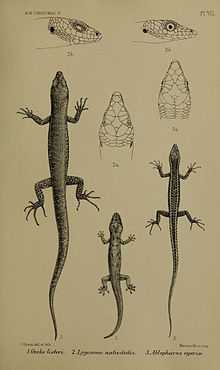Blue-tailed Skink
| Blue-tailed skink | |
|---|---|
 | |
| Cryptoblepharus egeriae (right) | |
| Scientific classification | |
| Kingdom: | Animalia |
| Phylum: | Chordata |
| Subphylum: | Vertebrata |
| Class: | Reptilia |
| Order: | Squamata |
| Suborder: | Sauria |
| Infraorder: | Scincomorpha |
| Family: | Scincidae |
| Genus: | Cryptoblepharus |
| Species: | C. egeriae |
| Binomial name | |
| Cryptoblepharus egeriae (Boulenger, 1888) | |
| Synonyms | |
The blue-tailed skink (Cryptoblepharus egeriae) is a species of skink, a lizard native to Australia's Christmas Island, and is not closely related to the Plestiodon skinks of North America, whose juveniles are known for their blue tails. It is relatively small with a black body with yellow stripes going to a bright blue tail.
Etymology
The specific name, egeriae, is in honor of HMS Egeria.[2]
Characteristics
Blue-tailed skinks are usually about 4 to 8 cm (1.6 to 3.1 in) long. When they become frightened, they have the ability to pop their tail off, and it will continue to wiggle and distract their predator while they run away. When young they have a dark black body with bright yellow stripes leading from the back of the neck down to the meeting of the bright blue tail. As the juvenile males age, they lose their yellowish stripes and their back starts to become a brownish black colour, and they begin to grow a reddish colour underneath the neck during the mating seasons. Females usually keep their blue tail for their whole life, though. It is thought that the bright colouring on the tail is intended to direct the predator's attention to it, instead of the vulnerable body.[3] They also have a snake-like head and appear to hold a Jacobson's organ, as they exhibit the "tongue-flicking" snakes use to "taste" their surroundings.
Diet
The blue-tailed skink eats small insects and worms.
Habitat
Blue-tailed skinks often burrow and build tunnels so they have access to a hole at any time. They can usually climb very well. They are commonly observed on low vegetation and low on tree trunks.[3]
References
- ↑ "Cryptoblepharus egeriae ". The Reptile Database. www.reptile-database.org.
- ↑ Beolens B, Watkins M, Grayson M. 2011. The Eponym Dictionary of Reptiles. Baltimore: Johns Hopkins University Press. xiii + 296 pp. ISBN 978-1-4214-0135-5. (Cryptoblepharus egeriae, p. 81).
- ↑ 3.0 3.1 http://www.reptilechannel.com/lizards/lizard-species/blue-tailed-skink.aspx
Further reading
- Boulenger GA. 1888. On the Reptiles of Christmas Island. Proc. Zool Soc. London 1888: 534-536. ("Ablepharus egeriæ ", new species, pp. 535-536).